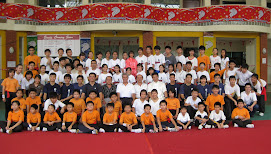一十三级,五色手腕带~ 黑,蓝,红,黄,白。
There are basically 3 levels in the grading system - Elementary, Intermediate and Advance. The grading consist of 5 different coloured wrist band (white, yellow, red, blue, black) spread over 13 different grades.

There are 5 complusory routine that student need to learn throughout the elementary and intermediate level:
五步功 - wu bu gong
六路弹腿 - liu lu tan tui
综合拳 - zong he quan
形意五形 - xing yi wu xing
八极小架 - ba ji xiao jia
Students are to complete the 1st two routine before starting of the elementary white grades.

In Elementary level (White & Yellow), it aims to equip student with knowledge of 4 basic weapons(刀,枪,剑,棍) and 1 baisc quan(拳) routine.
Upon graded on 3 basic routine, student will be promoted to elementary yellow grades
In Intermediate level (Red), it aims to equip student will more detailed knowledge on the wushu form that they practise and also to expose them to more competitive wushu and traditional wushu. (routine are to be taught depending on the student's standard and level of understanding)
e.g.

Competitive Form
竞赛南拳, 长拳(新/旧) ,刀术(新/旧), 枪术(新/旧), 棍术(新/旧), 剑术(新/旧)
Traditional Form

太极拳, 形意拳, 八卦掌, 八极拳, 六合拳, 翻子拳, 劈挂拳, 螳螂拳, 查拳, 少林一支梅, 蛇猫鹤, 三节棍, 九节鞭, 等等。。
Students are only allow to promote to intermediate blue grades upon completion of intermediate red grades criteria.
In Intermediate level (Blue), it aims to equip students with at least one of the traditional form wushu and actual application of wushu. Students will also have the chance to practise 太极推手at this grade.
In Advance level (Black), students are to specialise in one form of routine and practise practical wushu combat routine.












 Pasir Ris Zone 12 RC Wushu Club Pinic 2008(above)
Pasir Ris Zone 12 RC Wushu Club Pinic 2008(above)









+-+Type+1+-+COLOUR.jpg)


+-+Type+1+-+COLOUR.jpg)